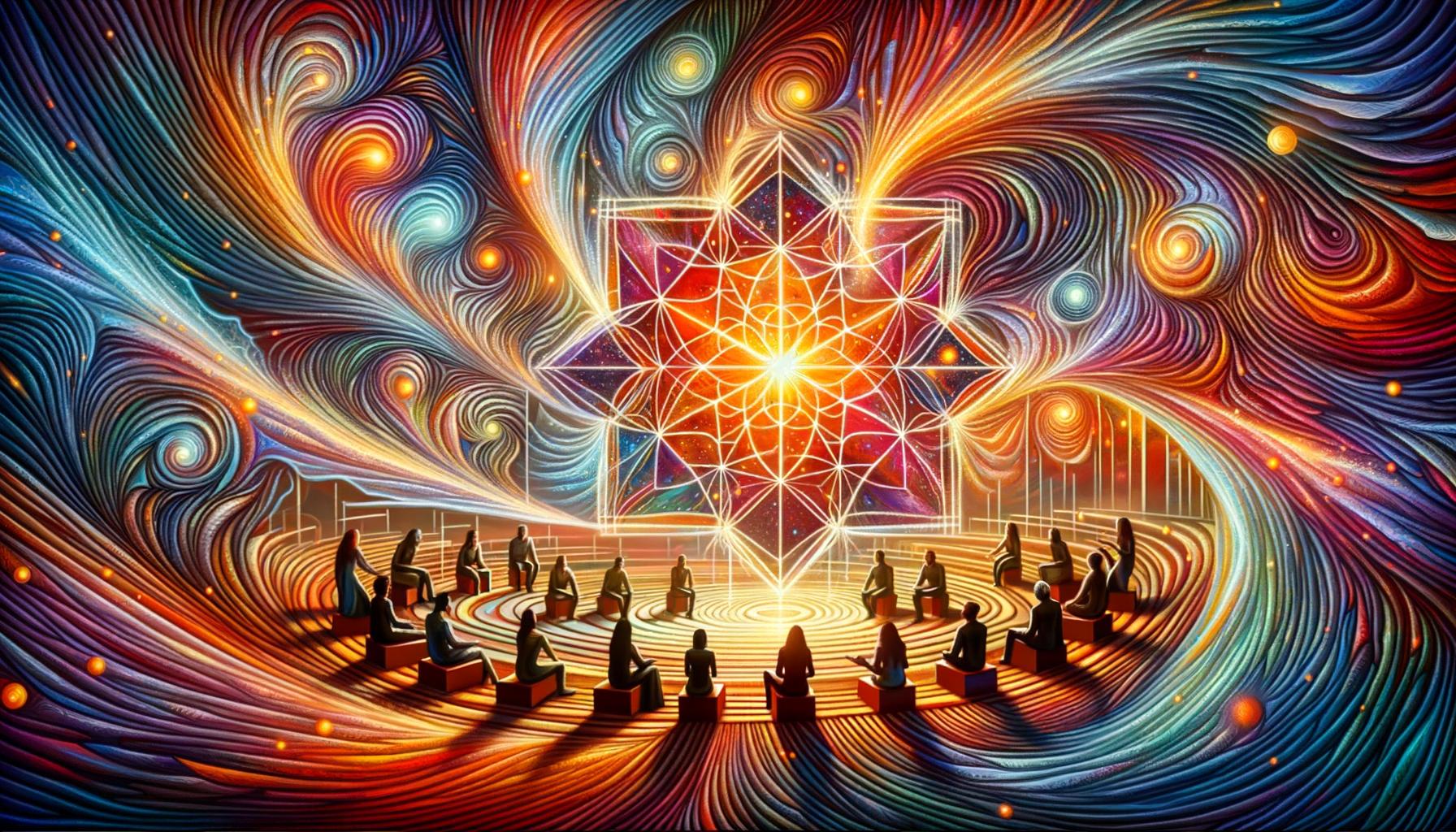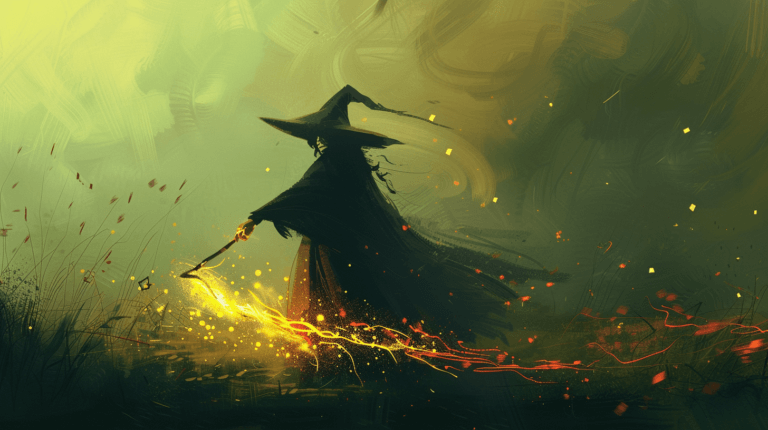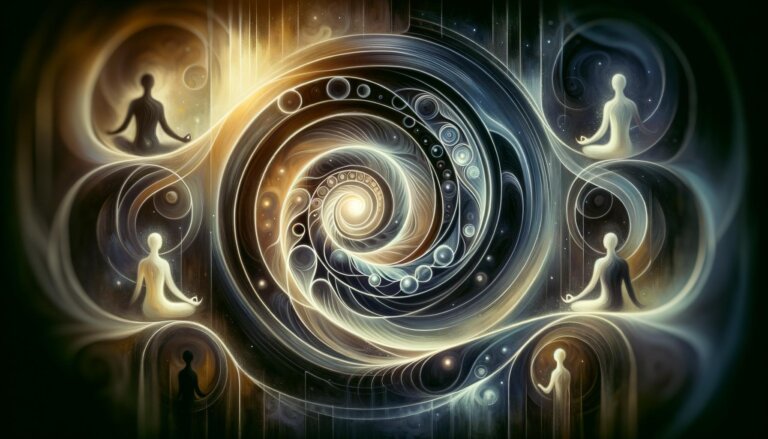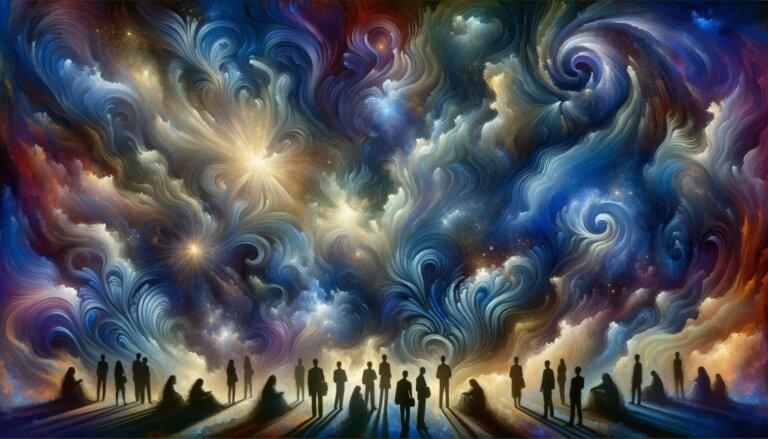How Crowley and Kabbalah Intersect
At Izabael’s Occult Review, we’re diving headfirst into the twisty maze that is Crowley and Kabbalah. Aleister Crowley—yep, that guy, the rock star of Western esotericism—left a mark on Kabbalistic thought and practice that’s as indelible as a tattoo.
So, what’s the scoop? This post is a deep dive into how Crowley’s idiosyncratic takes on Kabbalah spiced up his magical system and left a lasting footprint on modern occultism. We’re gonna untangle the Kabbalistic threads in Crowley’s patchwork quilt of ideas and, oh boy, there are debates. Lots of debates. Stick around—it’s gonna get wild.
How Crowley Discovered Kabbalah
The Golden Dawn’s Influence
Aleister Crowley’s dive into Kabbalah started in his early twenties-firing up a lifelong obsession with Western esotericism. Fast-forward to 1898, and at the ripe age of 23, Crowley jumped into the Hermetic Order of the Golden Dawn. This secret society? It basically turbocharged his magical practices and Kabbalistic grasp.

So, what’s the scoop with the Golden Dawn? They introduced Crowley to Kabbalistic ideas-a mixed bag of Hermeticism, Rosicrucianism, and Kabbalah. This late-19th-century occult melting pot gave him a fresh look at the Kabbalistic Tree of Life, which would later be a cornerstone in his work.
Crowley’s Golden Dawn era wasn’t just a casual stroll-he studied under big shot occultists like Samuel Liddell MacGregor Mathers and Allan Bennett. These guys shaped his Kabbalistic know-how and how it could be used in ceremonial magic. And man, did he climb those Golden Dawn ranks quickly, flashing his knack for magic and his growing grip on Kabbalistic principles.
Crowley’s Unique Approach
Deep in Kabbalah studies, Crowley spun his own interpretations and practices. He wove Kabbalistic concepts into his Thelema system, mixing in ideas from Eastern philosophies and his own mystical experiences. The end result? A unique take on Kabbalah that often went a bit left-field from traditional Jewish takes.
One of his big contributions? His work on gematria-a Kabbalistic way of deciphering Hebrew words via their numerical values. Crowley pushed the envelope, applying this method to English words and phrases in what he christened English Qabalah. This spin-off opened up new doors for interpreting magical texts and rituals, setting the stage for more occult adventures.
Practical Applications
Crowley didn’t just pontificate-he made Kabbalah practical for magic enthusiasts. He whipped up exercises and rituals that roped in Kabbalistic elements, like meditation on the Tree of Life and invoking divine names from Hebrew letters. This hands-on stuff still echoes in modern occult circles and remains a go-to for Thelemic magic students.
Curious about Crowley’s Kabbalistic insights? His book “777 and Other Qabalistic Writings” serves up a deep dive into his system. It’s got exhaustive correspondences between Kabbalistic paths, Tarot cards, and various magical and mundane concepts-practically a how-to manual for occult practitioners.
The Legacy of Crowley’s Kabbalistic Work
Crowley’s impact on contemporary Kabbalistic practice? Significant (and, yes, controversial). His interpretations blew open the scope of Western esoteric thought, continuing to stoke the fires of magical practice worldwide. The fusion of Kabbalistic elements into Thelema birthed a unique system-blending age-old wisdom with modern occult philosophy.
The next step? Digging deep into the key Kabbalistic bits in Crowley’s work, unearthing how he stitched these ancient concepts into the very fabric of his magical system.
Crowley’s Kabbalistic Toolkit
The Tree of Life Reimagined
So, Aleister Crowley-ever the disruptor-took Kabbalistic elements and cranked them up to eleven for his magical system. His rendition of the Tree of Life? The linchpin of Thelemic philosophy. Think of it as a spiritual GPS for those on the magical freeway.
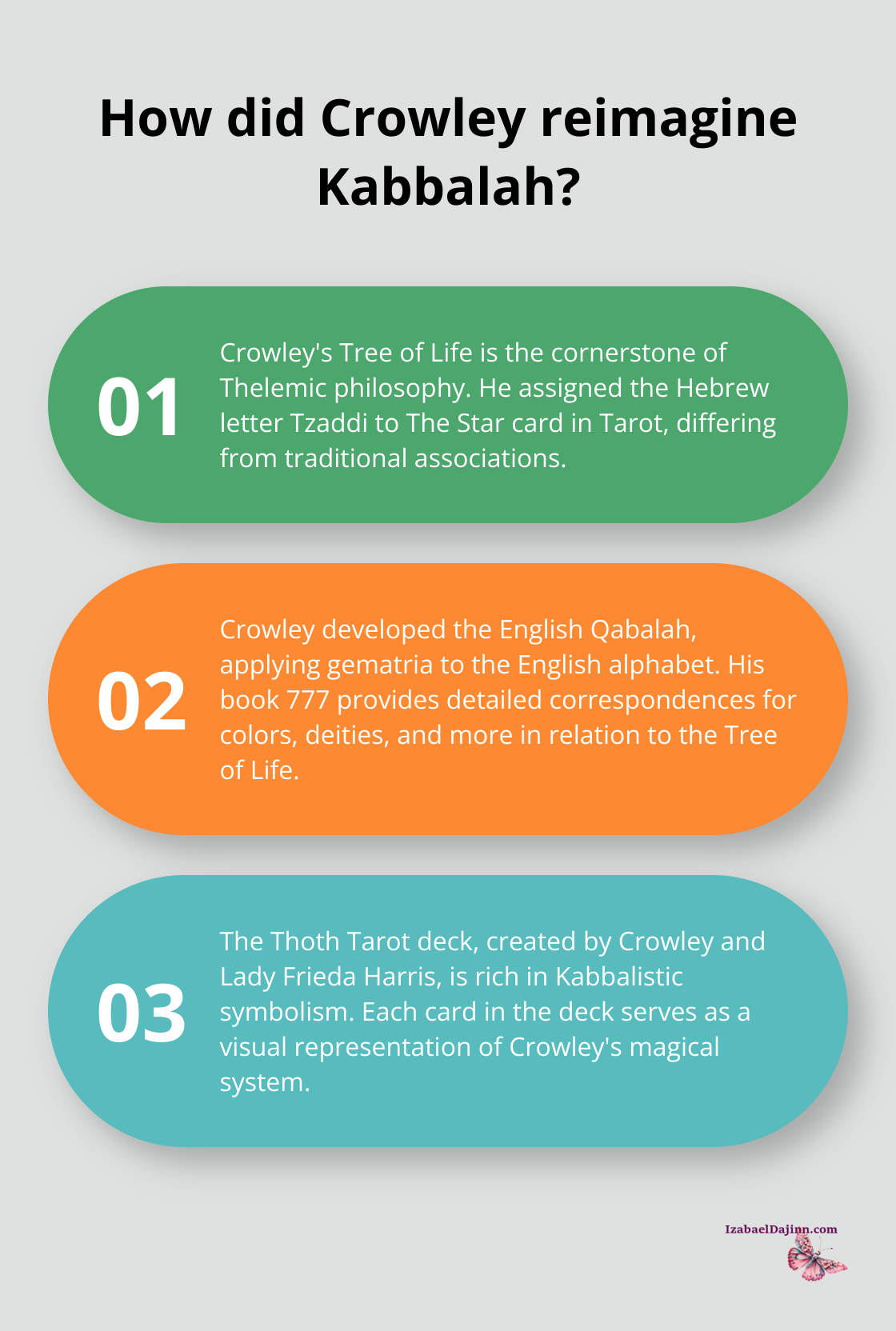
Crowley’s take on the Tree of Life? Yeah, it’s not your granddad’s version. He flipped the script by assigning the Hebrew letter Tzaddi to The Star card in the Tarot. Traditionalists would’ve paired it with The Emperor. This wasn’t a casual switch-Crowley was serious about intuition and personal gnosis steering your magical steering wheel.
If you’re itching to dive into Crowley’s Tree of Life, grab his book 777 first. It’s not light reading, but it’s got everything-every esoteric detail from colors to Egyptian deities linked up. It’s like IKEA instructions for magicians, helping you build custom rituals and meditations based on Tree of Life pathways.
Gematria: A Numerical Adventure
Crowley took gematria-the mystical practice of assigning numerical values to letters-and basically gave it a Red Bull. He rolled out the English Qabalah, where gematric principles meet the English alphabet. It’s like putting nitro in your mystical engine. Ancient Gematria? Sure. But Crowley’s twist on it? A whole new ball game.
Want to test drive Crowley’s gematria? Here’s how: Take a significant word or phrase from your magical toolkit. Use Crowley’s English Qabalah to convert each letter into its numerical counterpart. Then, find other words or phrases matching that number. It’s like magical Sudoku-hidden connections pop out, sparking fresh magical ideas.
Tarot and Kabbalah United
The Thoth Tarot deck, birthed by Crowley and Lady Frieda Harris, is bursting at the seams with Kabbalistic stuff. Each card is a visual info-dump of Crowley’s system. Seriously, the Thoth Tarot? It’s the holy grail for hardcore magicians.
New to the Thoth deck? Start with The Fool card. It’s intertwined with the Hebrew letter Aleph and the element of Air. Meditate on this card-absorb its Kabbalistic vibes. It’s like a workout for your mystical muscles, deepening your Tarot and Kabbalah game, maybe even triggering a-ha moments and magical boosts.
Practical Applications
Crowley’s Kabbalistic remix is a goldmine for today’s occultists. Want to explore? Experiment with these tools and techniques to grasp Thelemic philosophy more deeply. The secret sauce? Keep an open mind and be ready to play around.
(Interested in getting hands-on with Crowley’s Kabbalistic toolkit? Izabael’s Occult Review is a treasure chest of resources and guides.)
Next up, we’ll dive into how Crowley’s bold Kabbalistic twists drew both high praise and raised eyebrows in occult circles. His unique takes still echo in modern magical thought, poking traditional views and fueling fresh takes for new generations of practitioners.
How Crowley Revolutionized Kabbalah
The Book of the Law: A New Paradigm
Aleister Crowley’s approach to Kabbalah-well, it’s nothing short of a radical makeover. His big work, The Book of the Law, scribbled down in 1904, totally flipped the script on Kabbalistic norms. Crowley didn’t just sit and write this himself; nope, he claimed it was dictated by a supernatural entity named Aiwass. And voilà, it became the cornerstone of Thelema, his brand new spiritual and philosophical gig.
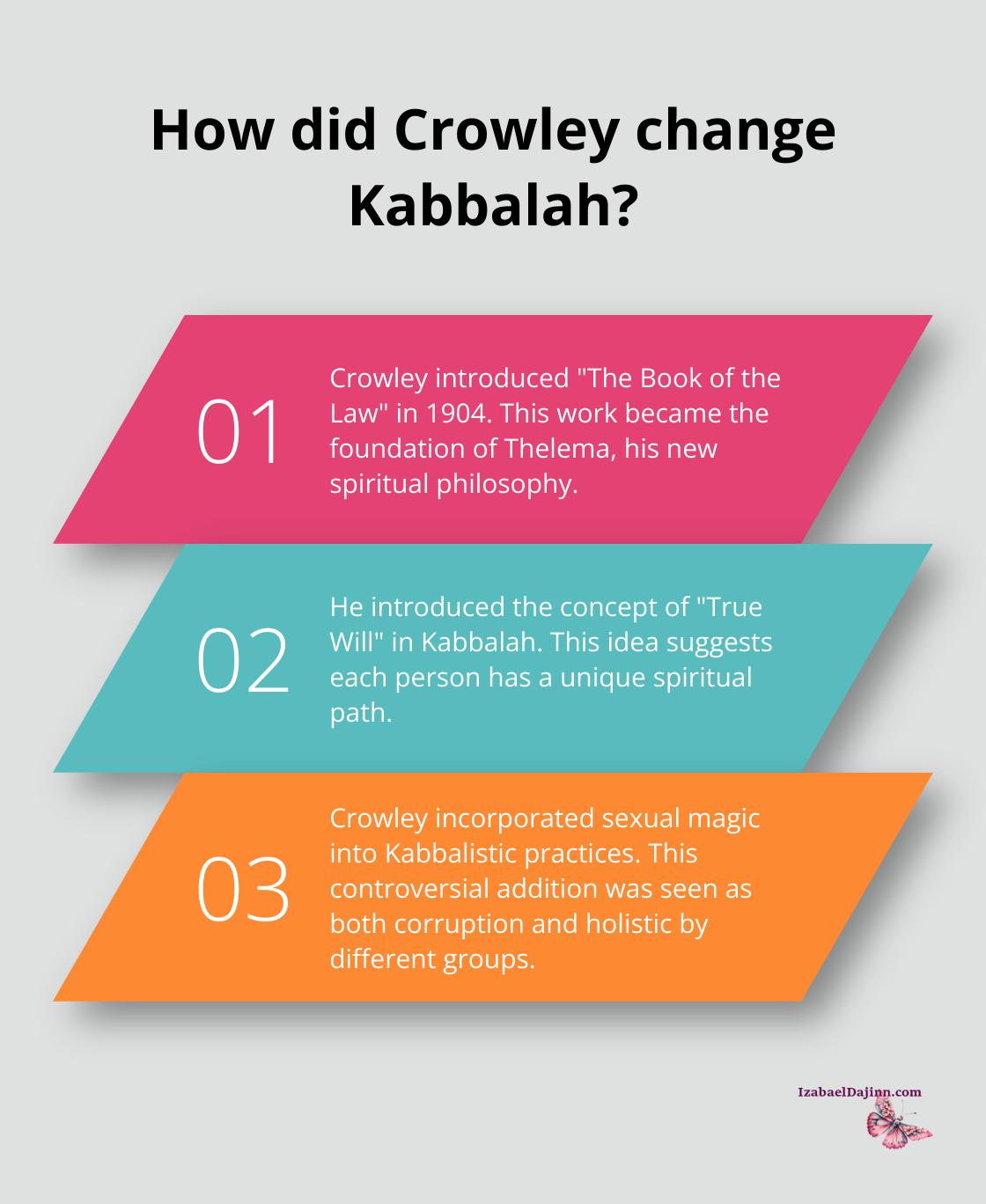
What really turned heads was the introduction of “True Will”-sounds Kabbalistic, right? But with a Crowley twist. Each person has their own unique spiritual path, flipping the traditional Kabbalistic idea of a one-size-fits-all divine journey. Radical.
Thelema and Kabbalah: A Provocative Fusion
Crowley’s Thelemic system-think: Kabbalah, but on steroids. He borrowed heavily from the Kabbalistic toolbox but retooled it for personal empowerment. The central mantra here, “Do what thou wilt shall be the whole of the Law,” is like Kabbalah’s creed, but with a punk rock twist. It’s all about free will and divine purpose but on your terms.
His ritual magic? Next level. Check out Liber Resh vel Helios-a daily solar… meditation with Kabbalistic flair.
Controversy and Criticism: A Mixed Reception
Cue the drama. Traditional Kabbalists were not amused. They thought Crowley went rogue, cherry-picking elements to pimp out his own philosophy. Some even accused him of spiritual appropriation. Ouch.
Then there’s the sexual magic. Crowley wove this into Kabbalistic practice, and let’s just say it ruffled more than a few feathers. Was it a corruption? Maybe. But some argue it made for a more holistic spirituality-addressing stuff traditional practices overlooked.
Modern Impact: A Lasting Legacy
Despite the haters, Crowley’s mark on modern occultism is… undeniable. From chaos magic to neo-paganism, you can trace his influence. His focus on personal gnosis and hands-on experimentation has pushed spiritual practice into a more individualistic realm.
Curious about Crowley’s Kabbalistic twists? His book “777 and Other Qabalistic Writings” is the go-to manual-offering a comprehensive guide and practical workouts to apply his principles in your own spiritual hustle.
Final Thoughts
Aleister Crowley’s impact on Kabbalah and Western esotericism-huge. His radical reinterpretation of Kabbalistic principles? It birthed a unique system that’s still hooking spiritual seekers today. Crowley mashed up Kabbalah with his Thelemic philosophy, pushing a more ‘you do you’ approach to spirituality. And guess what? It vibes with today’s culture.

Now, about modern views on Crowley’s Kabbalah remix-they’re all over the place. Traditionalists? Not fans… they grumble about his deviations from the ‘real’ stuff. But many current occultists? They dig it. Crowley’s work cracked open new paths for diving into Kabbalistic ideas, making the mystical mumbo-jumbo more digestible… and more open to the masses.
So, Crowley and Kabbalah-they’re kind of like peanut butter and jelly in today’s esoteric scene. His spin on Kabbalistic principles gave people a DIY toolkit for their spiritual and magical journeys. For those who want to dive deeper into this Crowley-Kabbalah lovefest, Izabael’s Occult Review is a treasure trove of goodies (think love spells and protection rituals).
